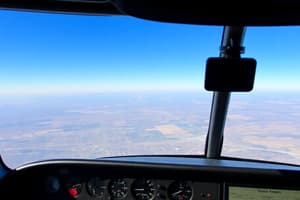Podcast
Questions and Answers
What is the primary difference between Minimum Descent Altitude (MDA) and Decision Altitude (DA)?
What is the primary difference between Minimum Descent Altitude (MDA) and Decision Altitude (DA)?
- MDA is used in precision approaches, whereas DA is used in non-precision approaches
- MDA is a decision point, whereas DA is a hard minimum altitude
- MDA is used in non-precision approaches, whereas DA is used in precision approaches
- MDA is a hard minimum altitude, whereas DA is a decision point (correct)
In an ILS approach, what is the minimum altitude?
In an ILS approach, what is the minimum altitude?
- Decision Altitude (DA) (correct)
- Missed Approach Altitude (MAA)
- Minimum Descent Altitude (MDA)
- Visual Descent Point (VDP)
What is the purpose of the Visual Descent Point (VDP) in a non-precision approach?
What is the purpose of the Visual Descent Point (VDP) in a non-precision approach?
- To decide when to execute a missed approach (correct)
- To indicate the Decision Altitude (DA)
- To determine the Minimum Descent Altitude (MDA)
- To determine the type of approach guidance being used
What is the required scale deflection for vertical and lateral guidance in a precision approach?
What is the required scale deflection for vertical and lateral guidance in a precision approach?
What is the buffer required for the Minimum Descent Altitude (MDA) in a non-precision approach?
What is the buffer required for the Minimum Descent Altitude (MDA) in a non-precision approach?
What is critical for pilots to brief themselves on to avoid common mistakes during instrument checkrides?
What is critical for pilots to brief themselves on to avoid common mistakes during instrument checkrides?
Flashcards are hidden until you start studying
Study Notes
-
Instrument approach failures often occur due to misunderstanding of altitude minimums, specifically distinguishing between Minimum Descent Altitude (MDA) and Decision Altitude (DA).
-
MDA is a hard minimum altitude, whereas DA is a decision point to decide whether to continue descent or execute a missed approach.
-
In an ILS (Instrument Landing System) approach, the minimum altitude is a Decision Altitude, allowing pilots to descend below it briefly while executing a missed approach.
-
In a Localizer approach, the minimum altitude is a Minimum Descent Altitude, and pilots must maintain it until the missed approach point.
-
The Visual Descent Point (VDP) is an indicator of when to decide to execute a missed approach in a non-precision approach.
-
Precision approaches, like ILS, require maintaining no more than a three-quarter scale deflection of the vertical and lateral guidance.
-
Non-precision approaches, like Localizer, require maintaining the MDA with a buffer of +100 feet and -0 feet.
-
In an RNAV (Area Navigation) approach, pilots must know the type of guidance being used to determine whether the minimum altitude is a DA or MDA.
-
Different types of approach guidance, such as LPV (Localizer Performance with Vertical Guidance) and LNAV (Localizer Navigation), have distinct minimum altitudes.
-
Pilots must brief themselves on the type of approach and minimum altitude to avoid common mistakes during instrument checkrides.
Studying That Suits You
Use AI to generate personalized quizzes and flashcards to suit your learning preferences.



